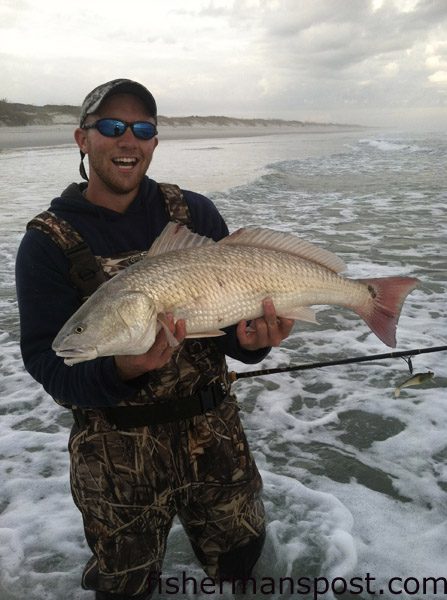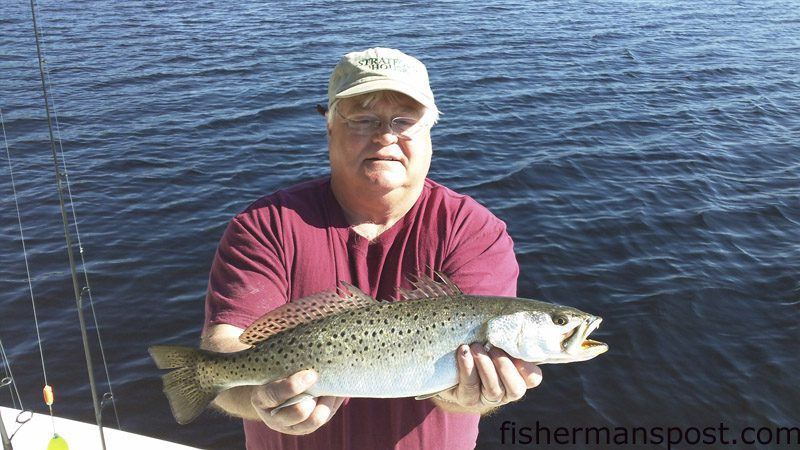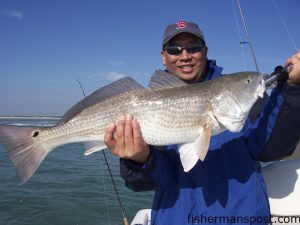Swansboro December 15, 2011

Will Cheek, of Swansboro, with a 30" red drum he caught and released after it struck a swimbait in the Hammock's Beach surf while he was fishing with Julian Swart.
Rob, of Sandbar Safari Charters, reports that speckled trout are feeding all over the Swansboro backwaters, with good action in the creeks and around inshore structure. Live mud minnows and Gulp baits are top choices for the specks in the cooler winter water. The trout action should continue to be strong over the coming weeks and months as long as the area doesn’t see an extended period of very cold weather.
Small schools of red drum are feeding in the shallow, soft-bottomed bays in the area. Searching for the reds with the trolling motor and then stopping to cast to fish that anglers see is the way to connect with the reds in the bays.
There are also big schools of reds in the surf zone around Bogue Inlet and up and down the beachfront. Calm days will allow anglers to go scouting in boats just beyond the breakers and seek out the schools. Gulp baits on heavier jigheads than anglers are casting inshore will tempt bites from the reds in the ocean.

Steve Wilkinson, of Danville, NC, with a fat speckled trout he hooked on a live shrimp in the backwaters near Swansboro while fishing with Capt. Chris Sewell of Fishead Charters.
Flounder are still feeding around ledges, wrecks, and other bottom structure 5-10 miles off Bogue Inlet. Bouncing 1-2 oz. bucktails tipped with Gulp baits off the bottom is the way to connect with these offshore flounder.
Jeff, of FishN4Life Charters, reports that anglers can expect to find action with speckled trout and red drum in the area on mild days all winter long.
The trout will be feeding in feeder creeks off Queens Creek, as well as in the Neuse, White Oak, and New Rivers. Scented soft baits like Gulps are top choices for the wintertime trout, and it’s key to work them very slowly in the cold water, allowing the fish to follow the scent trail to the baits. Using lighter jigheads with the soft baits is also important, and a good rule of thumb is to use 1/16 oz. heads in under 5’ of water, 1/8 oz. in 5-10’, and 3/16 oz. in water deeper than 10’. Stronger currents will call for a slightly heavier head.
Winter days with light winds will give anglers opportunities to sight-cast to red drum holding in the surf zone and on the mud flats in the backwaters. The shallow, muddy bottoms further up the creeks and rivers will absorb the sun’s heat and warm the surrounding water, creating better feeding conditions. Areas adjacent to deeper water and with protection from northerly winds offer the best chances of success. As with the trout, it’s hard to beat light jigheads and Gulp baits for casting to the winter reds.
The reds feeding in the surf will be schooled up along the beaches and around the inlet shoals. Anglers can look for the fish from the boat, and then cast a variety of lures into the schools to hook up.

Mike Jeuick, from VA, with a red drum he hooked on a 4" Gulp shrimp while sight-casting to schools of reds near Bogue Inlet with Capt. Jeff Cronk of Fish'N4Life Charters.
Josh, of The Reel Outdoors, reports that anglers are catching plenty of speckled trout in the Emerald Isle surf right now. Many of the fish are undersized, but anglers are connecting with the larger trout in the early morning and late afternoon hours. Soft plastic jerkbaits on stand up jigheads are producing most of the action with the surf specks.
A few red drum are also feeding in the surf zone, but the bite has been better at Bear Island than Emerald Isle.
The surf trout bite will be slowing down as the water temperatures drop into the lower 50’s, but anglers should be able to find some trout throughout the winter up the local creeks and rivers. Gulp baits and live mud minnows will tempt bites from the trout inshore.
